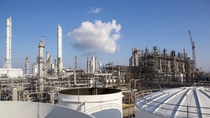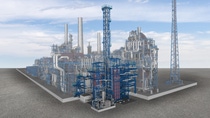We are on our way
Plastics & Rubber
The transformation task: shifting away from fossil resources
Our society is facing one of the biggest economic, ecological, and technical transformations in modern times. Companies are faced with the challenge of reducing CO2 emissions and taking a major step toward environmentally friendly plastic production. BASF needs to rethink how plastics are made, used, and recycled, with the goal to keep carbon in production cycles and to generate as few emissions as possible.
BASF follows multiple approaches to systematically reduce the Product Carbon Footprint (PCF) of its offerings. Through various strategic levers, BASF is actively working toward lowering CO2 emissions across its entire production portfolio.
How is BASF transforming toward net zero emissions in plastic production?
BASF is already working on making the most of plastics during their use phase and lifecycle end, creating new valuable resources from plastic waste through recycling. When it comes to the production of plastics, the situation is different: It remains energy-intensive and is still associated with high CO2 emissions.
At the same time, plastics are a prerequisite for many value chains across almost all industries. They will continue to play a major role in modern society in the future. The solution must be to manufacture plastics with as little environmental impact as possible.

How does BASF minimize CO2 emissions through optimized production processes and sustainable energy?
A central component of BASF's approach for reducing greenhouse gas emissions is shifting the energy supply to renewable sources. This measure applies to both electricity and steam supply and production processes, where fossil fuels are increasingly replaced with energy from renewable sources.
The electrification of processes will significantly increase the BASF Group's green power demand over the coming years. In 2024, renewables accounted for 26 percent of BASF's global power demand. By 2030, BASF aims to source more than 60% of power needs from renewable sources. BASF believes that improving production processes and scaling up new technologies will bring the company a big step closer to reaching net zero targets. Detailed information about BASF's efforts to implement energy from renewable sources can be found here: BASF Report 2024.
How is BASF shifting to alternative feedstocks, and what role does mass balance play in that transition?
To become more sustainable, BASF uses recycled and renewable raw materials instead of fossil alternatives. BASF is therefore developing new material cycles and business models to promote the circular economy. One pillar in this regard is ChemCycling®. BASF uses recycled feedstock derived from plastic waste for its broad Ccycled® product portfolio. The recycled feedstock is attributed to the certified Ccycled® products through a Mass Balance Approach.
The Mass Balance Approach allows BASF to integrate alternative raw materials such as renewable and recycled materials into its chemical production processes. The approach use raw materials flexibly to maximize efficiency, support fossil resource substitution and respond to the growing demand for sustainable solutions.
Thanks to networked plants and optimized processes, BASF uses all materials in the most efficient way. Customers can process more than 1,500 certified mass-balanced products using conventional methods - with consistent performance and proven environmental benefit.
More information about the Mass Balance Approach can be found here, and our efforts in building new circular feedstocks, new material cycles and new business models can be learnt about here.

The goal: Reduced Carbon Footprints of BASF’s product offering
With its various measures to reduce CO2 emissions, BASF offers its customers a range of levers to drive forward their green transformation. This allows each customer to make environmentally conscious purchasing decisions at their preferred speed.
Therefore, BASF has developed a digital application to calculate the cradle-to-gate PCFs for its 40,000 sales products. It enables BASF to provide PCFs for its global portfolio. Customers thus receive valuable information about the extent to which BASF materials contribute to the carbon footprint of their business activities and their own final products.
BASF's PCF calculation is based on the Greenhouse Gas Protocol (GHG) emissions from its own plants and high-quality average data for purchased raw materials as well as purchased energy.
Through this comprehensive set of measures - from renewable energy adoption to alternative raw materials and advanced calculation methods - BASF is systematically working toward reducing the Product Carbon Footprint of its offerings and supporting customers in their own sustainability goals.
Click here for more information on our way to climate neutrality in production beyond plastics: Our Carbon Management.

By using green power, low-carbon steam, renewable feedstocks, and highly efficient processes – we will be able to offer products with a distinctly lower carbon footprint and, ultimately, aim towards net zero products. In this regard, we are a pacemaker for other industries to rethink their processes towards a net zero circular economy, too.
